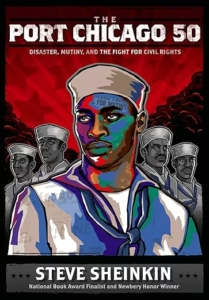The Port Chicago 50: Disaster, Mutiny, and the Fight for Civil Rights
Steve Sheinkin
Roaring Brook Press
Published January 21, 2014
Amazon | Bookshop | Goodreads
About The Port Chicago 50: Disaster, Mutiny, and the Fight for Civil Rights
An astonishing World War II military story of civil rights from New York Times bestselling author and Newbery Honor recipient Steve Sheinkin.
A National Book Award Finalist
A YALSA Award for Excellence in Nonfiction Finalist
A School Library Journal Best Book of the Year
On July 17, 1944, a massive explosion rocked the segregated Navy base at Port Chicago, California, killing more than 300 sailors who were at the docks, critically injuring off-duty men in their bunks, and shattering windows up to a mile away. On August 9th, 244 men refused to go back to work until unsafe and unfair conditions at the docks were addressed. When the dust settled, fifty were charged with mutiny, facing decades in jail and even execution.
The Port Chicago 50 is a fascinating story of the prejudice and injustice that faced black men and women in America’s armed forces during World War II, and a nuanced look at those who gave their lives in service of a country where they lacked the most basic rights.
This thoroughly-researched and documented book can be worked into multiple aspects of the common core curriculum, including history and social studies.
“Sheinkin delivers another meticulously researched WWII story, one he discovered while working on his Newbery Honor book, Bomb…Archival photos appear throughout, and an extensive bibliography, source notes, and index conclude this gripping, even horrific account of a battle for civil rights predating Rosa Parks and Martin Luther King, Jr.” —Publishers Weekly (starred review)
My Review
This is a moment in history that I didn’t have knowledge of. If we learned about it in school, it must have been a very brief mention. So the information about the explosion at Port Chicago was new to me. It’s well-explained, with some set-up information and context. Sheinkin’s goal was to tell the story from the perspective of the men involved, and he succeeds.
What’s also excellent about The Port Chicago 50 is how Sheinkin orients readers using other familiar historical events. This disaster happened two and a half years after the attack on Pearl Harbor and just over ten years before Rosa Parks refused to give up her seat on the bus. It happened almost three years before Jackie Robinson became the first Black major league baseball player. So, readers who are not familiar with this incident but know about other landmark moments in history can insert this information into the timeline of other familiar events pretty quickly.
I thought that was a really smart approach, and it made reading the book feel like it helped me piece together American history in a fresh way.
The author also highlights the fact that in the 1940s, people lived in two different, segregated Americas. Black Americans had trusted news sources that reported events that white newspapers were not covering. I’ve spent a lot of time in the last few years thinking about the divide between where different Americans get their news. It was eye-opening to realize that this has been true for much longer than I was aware. (Nothing like reading a book to help you confront privilege.)
Conclusion
It’s easy to see why this book was a National Book Award finalist the year it was published. It brings light to a too often overlooked moment in history. The Port Chicago disaster sparked big changes in civil rights. It also left 50 men who served their country wrongly branded as mutineers.
This excellent book about historical events worth remembering is perfectly tailored to its intended audience.
Content Notes
Recommended for Ages 10 up.
Profanity/Crude Language Content
Some mild profanity in significant quotes from witnesses and key historical figures. References to the F-word, but it’s bleeped out. The author clarifies that the whole word was used in the trial.
Romance/Sexual Content
None.
Spiritual Content
None.
Violent Content
References to racism and racist slurs. Sheinkin notes stories of Black servicemen who were attacked and then blamed for their attack.
Some brief descriptions of the explosion at Port Chicago and the resulting injuries. Some men had PTSD symptoms afterward and were victimized by a fellow serviceman who would play startling pranks on them. For example, he would tangle his bedsheet in a box fan to create a loud rattling noise.
When some men refused an order by their commanding officer, some were told they would be shot.
Drug Content
Reference to adults visiting a bar to ask for a beer.
Note: This post contains affiliate links, which do not cost you anything to use but help support this blog. All opinions are my own.
Marvelous Middle-Grade Monday
I’m sharing this post as a part of a weekly round-up of middle-grade posts called Marvelous Middle-Grade Monday. Check out other blogs with posts about middle-grade books today on Marvelous Middle-Grade Mondays at Always in the Middle with Greg Pattridge.
